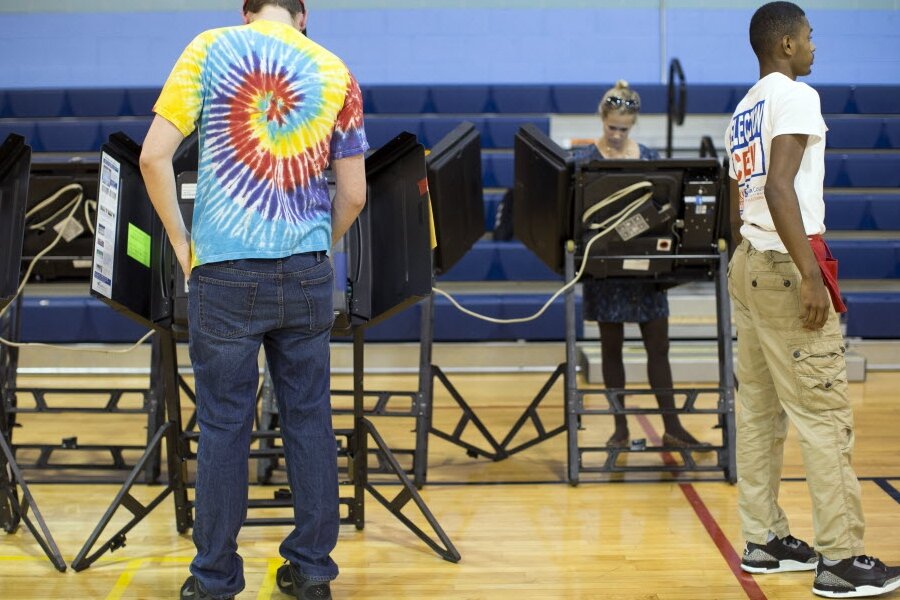How Ohio’s marijuana vote could tip federal decriminalization bid
Loading...
Last Tuesday, voters in Ohio rejected a constitutional amendment that would have legalized both recreational and medical marijuana usage. Naturally, folks are wondering about the implications of Issue 3’s failure for similar measures in other states.
But there’s a potentially larger question. Could the defeat of Ohio’s Issue 3 influence marijuana policy at the federal level – for instance, efforts to eliminate federal felony charges for nonmedical marijuana, or to influence related questions like Drug Enforcement Administration (DEA) funding, drug sentencing guidelines, and so on.
It certainly could.
In 2011, Dan Smith, Josh Huder, and I published an article in American Politics Research that explored whether the passage or failure of statewide ballot measures affects how members of Congress vote. In other words, do state ballot measures influence policy outcomes at the federal level?
Our theory was that that when a statewide ballot measure either passes or fails, it tells lawmakers precisely what their constituents want, down to the district level. That helps reduce “policy shirking,” in which lawmakers vote contrary to the wishes of their constituents.
Lawmakers care about one thing above all else: winning reelection. Reelection-minded lawmakers try their best to behave as pure delegates – and to faithfully represent their constituents’ views.
But a number of studies have shown that lawmakers can be poor judges of their constituents’ preferences on specific issues. While they may know how liberal or conservative their district is, lawmakers have incomplete knowledge of voters’ beliefs on more nuanced issues, like marijuana legalization.
And so lawmakers search for reliable information about what their constituents want. Public opinion polls are an obvious resource. But polls are not always accurate. For example, a handful of polls – including one at my alma matter, Bowling Green State University – suggested that Ohio’s decriminalization measure would pass. In fact, a Kent State University poll suggested Issue 3 would pass with a whopping 58 percent support. What’s more, people who respond to polls are not always the same people who turn out to vote, which is one reason polls are inaccurate. But for obvious reasons, lawmakers are especially interested in voters.
And so we theorized that a ballot measure’s results offer the best possible information lawmakers can use to figure out what their constituents want. It offers information that’s specifically about a single issue, as opposed to a lawmaker’s more general intuition about how liberal or conservative constituents are. And it reveals what voters want, not just what poll respondents want.
[A number of readers of the Washington Post article have pointed out that some voters opposed Issue 3 because of concerns about monopolies. I think it’s a fair point, but here’s my response. First, I still think Ohio’s congressional delegation will look at Issue 3’s defeat as a piece of information when trying to decide what their constituents want. I maintain that the vast majority of the votes for or against Issue 3 were ultimately about marijuana legalization. Indeed, it seems unlikely to me that 36% of Ohioans voted IN FAVOR of monopolies. Second, if you’re a lawmaker trying to decide where your constituents stand, it’s telling that pro-legalization voters were persuaded to vote against that issue because of something unrelated to legalization. I think that gives lawmakers some good information how much pro-legalization constitutions care about the issue.]
Here’s how we tested our hypothesis. We took the results of statewide ballot measures on three issues – regulating campaign finance, raising the minimum wage, and banning same-sex marriage – and compared that to how lawmakers voted on those issues.
Our hypothesis appears to be partly correct. Members of the House do vote in ways that appear to be influenced by how their constituents voted on ballot measures.
But that’s not true for senators – which makes sense. Senators are more insulated from public opinion than representatives, since they generally have a larger constituency and only have to go up for election every six years.
We also report in this paper that representatives are most likely to respond to what they learn about their median constituent – the constituent a lawmaker needs to win over in order to get at least half the vote.
In other words, the statistical results show that it matters little if the ballot measure passed with 70 percent of the vote or 51 percent of the vote. Both show a member of Congress where at least half of his or her constituency stands.
So how could the defeat of Ohio’s Issue 3 hurt federal efforts to decriminalize nonmedical marijuana use and so forth? First, it could influence Ohio’s 16 representatives. Second, it could affect how lawmakers in similar Midwestern states vote – although that’s a theory we do not test that in the paper.
Ohio’s decision on marijuana, in other words, has national implications.
Editor's note: An earlier version of this blog post was published by The Washington Post’s Monkey Cage blog.
Jordan Ragusa publishes his Rule 22 blog at http://rule22.wordpress.com.





